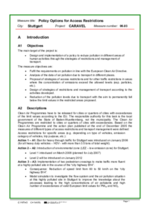Policy options for access restrictions
Summary
Access restrictions are the most effective way to reduce traffic volumes and bring down levels of air pollutants to conform to European air quality directives.
Implementing sustainable mobility
Stuttgart’s geographical location in a valley basin, along with its mild climate, low winds and surrounding industries have made it susceptible to poor air quality. Continuous air monitoring indicates high levels of traffic-related emissions (especially particulates and nitrogen oxides), with European limit values exceeded on some of Stuttgart’s busiest roads.
Under the CARAVEL project, various measures were designed, implemented and assessed in an effort to reduce air pollution and fulfil the requirements of the European Clean Air Directive. This included the Clean Air Programme and Action Plan, which were launched in December 2005. Access restrictions are the most effective means to permanently reduce the number of vehicles entering and passing through the city centre.
Progress
Since the emission factors for nitrogen oxides and particulates for heavy-duty vehicles are 20 to 30 times higher than for light-duty vehicles, the measure focused on heavy-duty vehicles. The access restrictions tested in Stuttgart within the CARAVEL project included:
- a year-round ban on heavy-duty vehicles passing through Stuttgart (January 2006);
- a year-round traffic ban on diesel vehicles that do not meet any EURO standard, with the exception of those retrofitted with soot particle filters (2007);
- a year-round ban on diesel vehicles that do not meet at least EURO 2 emissions standard, with the exception of those retrofitted with soot particle filters (2008); and
- the installation of two pedestrian crossings on a highly-polluted city road to reduce traffic speeds and prevent congestion (2006).
The measures were supported by a wide range of PR activities, including a roundtable on clean air and noise reduction in 2005; a public awareness campaign in 2006 highlighting the topic of particulates emissions and promoting environmentally friendly transport modes such as cycling, public transport and car pooling; and a survey among the general public in 2007 on the measures contained in the Clean Air Programme.
Outcomes
A total of 409 Stuttgart citizens were interviewed, 95 percent of whom knew about the problem of air pollution from particulates in the city. Some 65 percent of interviewees knew about the Clean Air Programme, and 79 percent supported a ban on heavy traffic through Stuttgart. They also welcomed the upgrading of the bicycle network (66 percent) and the traffic ban in the newly established environmental zone (65 percent).
On a 2-km section of monitored test road, the amount of heavy-duty vehicles fell by 11.5 percent, achieving emissions reductions of 8 percent.








